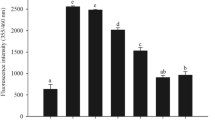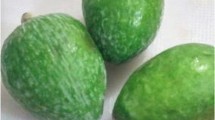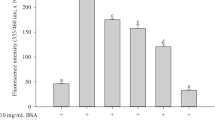Abstract
In the Maillard reaction, nonenzymatic glycation reaction reversibly produces Amadori rearrangement products which subsequently lead to the formation of irreversible advanced glycation end-product (AGE). These reactions are important in the pathogenesis of complications associated with diabetes. This study examined the antioxidant activity of rutin and related efficacy to inhibit glycation in three distinct tissue protein sources. Rutin and the rutin analogue exhibited significant antioxidant activity in a liposomal model reaction similar to quercetin. Incubation of rat muscle and kidney proteins with 50 mM glucose for 5 days resulted in the generation of N ε-fructoselysine (FL), a biomarker for initial stage glycation. The addition of G-rutin, a water soluble glucose derivative of rutin, to the incubation medium (0.1 mM) reduced (p < 0.05) FL production. AGE content in both muscle and kidney proteins was also increased (p < 0.05) with the addition of glucose in the incubation mixture, but completely suppressed by the presence of G-rutin. On the contrary, inhibition of FL and AGE formation by G-rutin was found to be comparatively less effective in bovine serum albumin than both muscle and kidney proteins. These results demonstrate that the antioxidant activity of G-rutin corresponds to a strong affinity to suppress the formation of both initial and advanced stages of Maillard reaction in tissue protein sources.
Similar content being viewed by others
References
Yaylyan VA, Huyghues-Despointes A: Chemistry of Amadori rearrangement products: Analysis, synthesis, kinetics, reactions, and spectroscopic properties. Crit Rev Food Sci Nutr 34: 321-369, 1994
Chellan P, Nagaraj RH: Protein crosslinking by the Maillard reaction: dicarbonyl-derived imidazolium crosslinks in aging and diabetes. Arch Biochem Biophys 368: 98-104, 1999
Odetti PR, Borgoglio A, De Pascale A, Rolandi R, Adezati L: Preventation of diabetes-increased aging effect on rat collagen-linked fluorescence by aminoguanidine and rutin. Diabetes 39: 796-801, 1990
Watanabe H, Ogasawara M, Suzuki N, Nishizawa N, Ambo K: Glycation of myofibrillar protein in aged rats and mice. Biosci Biotechnol Biochem 56: 1109-1112, 1992
Ryle C, Leow CK, Donaghy M: Nonenzymatic glycation of peripheral and central nervous system proteins in experimental diabetes mellitus. Muscle Nerve 20: 577-584, 1997
Schleicher ED, Wagner E, Nerlich AG: Increase accumulation of the glycoxidation product N ε-(carboxymethyl)lysine in human tissues in diabetes and aging. J Clin Invest 99: 457-468, 1997
Frye EB, Degenhardt TP, Thorpe SR, Baynes JW: Role of the Maillard reaction in aging of tissue proteins. J Biol Chem 273: 18714-18719, 1998
Manuel y Keenoy B, Vertommen J, De Leeuw I: The effect of flavonoid treatment on the glycation and antioxidant status in type 1 diabetic patients. Diab Nutr Metab 12: 256-263, 1999
Verzijl N, DeGroot J, Oldehinkel E, Bank RA, Thorpe SR, Baynes JW, Bayliss MT, Brjlsma JWJ, Lafeber FPJG, TeKoppele JM: Age-related accumulation of Maillard reaction products in human articular cartilage collagen. Biochem J 350: 381-387, 2000
Singh R, Barden A, Mori T, Beilin L: Advanced glycation end-products: A review. Diabetologia 44: 129-146, 2001
Chappey O, Dosquet C, Wautier M-P, Wautier J-L: Advanced glycation end products, oxidant stress and vascular lesions. Eur J Clin Invest 27: 97-108, 1997
Sima AAF, Sugimoto K: Experimental diabetic neuropathy: An update. Diabetologia 42: 773-788, 1999
Miyata T, Saito A, Kurokawa K, Van Ypersele de Strihou C: Advanced glycation and lipoxidation end products: Reactive carbonyl compounds-related uremic toxicity. Nephrol Dial Transplant 16(suppl 4): 8-11, 2001
Giardino I, Fard AK, Hatchell DL, Brownlee M: Aminoguanidine inhibits reactive oxygen species formation, lipid peroxidation and oxidant induced apoptosis, Diabetes 47: 1114-1120, 1998
Rice-Evance CA, Miller NJ, Bolwell PG, Bramley PM, Pridham JB: The relative antioxidant activities of plant-derived polyphenolic flavonoids. Free Radic Res 22: 375-383, 1995
Liao K, Yin M: Individual and combined antioxidant effects of seven phenolic agents in human erythrocyte membrane ghosts and phosphatidylcholine liposome systems: Importance of the partition coefficient. J Agric Food Chem 48: 2266-2270, 2000
Suzuki Y, Suzuki K: Enzymatic formation of 4G-α-glucopyranosylrutin. Agric Biol Chem 55: 181-187, 1991
Hu C, Kitts DD: Evaluation of antioxidant activity of epigalloocatechin gallate in biphasic model systems in vitro: Mol Cell Biochem 218: 147-155, 2001
Nagasawa T, Hatayama T, Watanabe Y, Tanaka M, Niisato Y, Kitts DD: Free radical-mediated effects on skeletal muscle protein in rats treated with Fe-nitrilotriacetate. Biochem Biophys Res Commun 231: 37-41, 1997
Markwell MAK, Hass SM, Biebra LL, Tolbert NE: A modification of the Lowry procedure to simplify protein determination in membrane and lipoprotein samples. Anal Biochem 87: 206-210, 1986
Foti M, Piatteli, M, Baratta MT, Ruberto GJ: Flavonoids, coumarins and cinnamic acids as antioxidants in a micellar system. Structure-activity relationships. J Agric Food Chem 44: 497-501, 1996
Funabiki R, Takeshita K, Miura Y, Shibasato M, Nagasawa T: Dietary supplement of G-rutin reduces oxidative damage in the rodent model. J Agric Food Chem 47: 1078-1082, 1999
Kakkar R, Mantha SV, Radhi J, Prasad K, Kalra J: Increased oxidative stress in rat liver and pancreas during progression of streptozotocin-induced diabetes. Clin Sci 94: 623-632, 1998
West IC: Radicals and oxidative stress in diabetes. Diabet Med 17: 171-180, 2000
Wohaieb SA, Godin DV: Alterations in free radical tissue-defense mechanisms in streptozocin-induced diabetes in rat. Effects of insulin treatment. Diabetes 36: 1014-1018, 1987
Elgawish A, Glomb M, Freedlander M, Monnier VM: Involvement of hydrogen peroxide in collagen cross-linking by high glucose in vitro and in vivo. J Biol Chem 271: 12964-12971, 1996
Lean MEJ, Noroozi M, Kelly I, Burns J, Talwar D, Sattar N, Crozier A: Dietary flavonols protect diabetic human lymphocytes against oxidative damage to DNA. Diabetes 48: 176-181, 1999
Sharma A, Kharb S, Chugh SN, Kakkar R, Singh GP: Evaluation of oxidative stress before and after vitamin E supplementation in diabetic patients. Metabolism 49: 160-162, 2000
Sanders RA, Rauscher FM, Watkins JB III, Effects of quercetin on antioxidant defense in streptozotocin-induced diabetic rats. J Biochem Mol Toxicol 15: 143-149, 2001
Morel DW, Chisolm GM: Antioxidant treatment of diabetic rats inhibits lipoprotein oxidation and cytotoxicity. Lipid Res 30: 1827-1834, 1989
Mossine VV, Linetsky M, Glinsky GV, Ortwerth BJ, Feather MS: Superoxide free radical generation by Amadori compounds: The role of acyclic forms and metal ions. Chem Res Toxicol 12: 230-236, 1999
Yamaguchi F, Ariga T, Yoshimura Y, Nakazawa H: Antioxidative and anti-glycation activity of garcinol from Garcinia indica fruit rind. J Agric Food Chem 48: 180-185, 2000
Brownlee M, Vlassara H, Kooney A, Ulrich P, Cerami A: Amino-guanidine prevents diabetes-induced arterial wall protein cross-linking. Science 232: 1629-1632, 1986
Ahmed MU, Thorpe SR, Baynes JW: Identification of N ε-carboxymethyllysine as a degradation product of fructose-lysine in glycated protein, J Biol Chem 261: 4889-4894, 1986
Ikeda K, Higashi T, Sano H, Jinnouchi Y, Yoshida M, Araki T, Ueda S, Horiuchi S: N ε-(Carboxymethyl)lysine protein adduct is a major immunological epitope in proteins modified with advanced glycation end products of the Maillard reaction. Biochemistry 35: 8075-8083, 1996
Zhao W, Devamanoharan PS, Varma SD: Fructose-mediated damage to lens α-crystallin: Prevention by pyruvate. Biochim Biophys Acta 1500: 161-168, 2000
Vasan S, Zhang X, Zhang X, Kapurniotu A, Bernhagen J, Teichberg S, Basgen J, Wagle D, Shih D, Teriecky I, Bucala R, Cerami A, Egan J, Ulrich P: An agent cleaving glucose-derived protein crosslinks in vitro and in vivo. Nature 382: 275-278, 1996
Miyata T, Ueda Y, Asahi K, Izuhara Y, Inagi B, Saito A, Van Ypersele de Strihou C, Kurokawa K: Mechanism of the inhibitory effect of OPB-9195 [(±-2)-isopropylidenehydrazono-4-oxo-thiazolidin-5-ylacetanilide] on advanced glycation end product and advanced lipoxidation end product formation. J Am Soc Nephrol 11: 1719-1725, 2000
Varma DS, Kinoshita JH: Inhibition of lens aldose reductase by flavonoids: Their possible role in the prevention of diabetic cataracts. Biochem Pharmacol 25: 2505-2513, 1976
Author information
Authors and Affiliations
Rights and permissions
About this article
Cite this article
Nagasawa, T., Tabata, N., Ito, Y. et al. Inhibition of glycation reaction in tissue protein incubations by water soluble rutin derivative. Mol Cell Biochem 249, 3–10 (2003). https://doi.org/10.1023/A:1024793429244
Issue Date:
DOI: https://doi.org/10.1023/A:1024793429244




